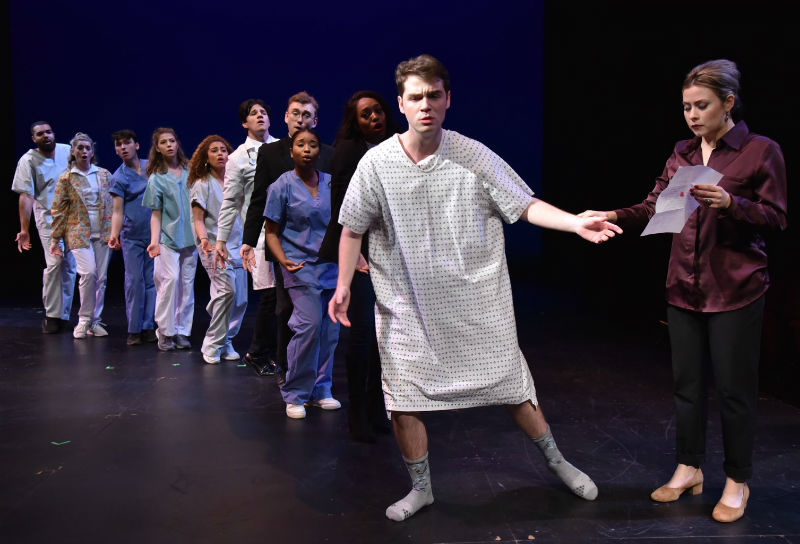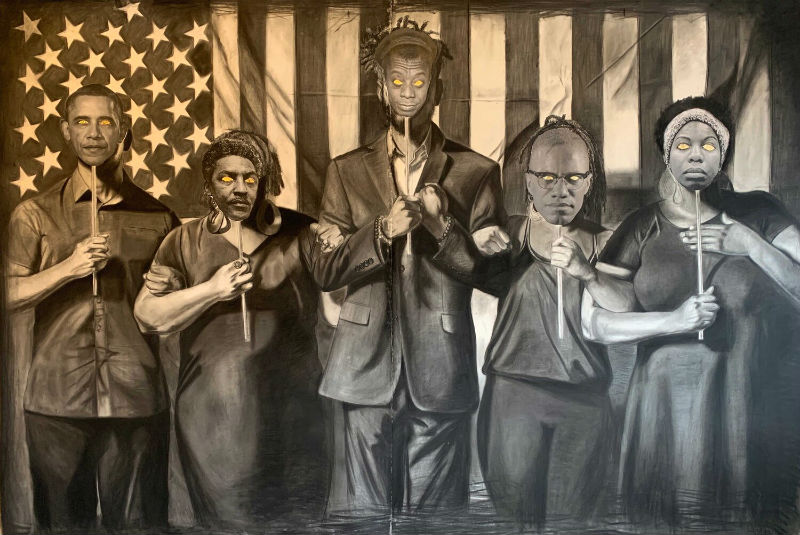Let’s Get Ready to Rumble: Ann Arbor Comedy Showcase features 30 female comics performing 90 seconds each

It started when comedian Bret Hayden decided to have a party.
“I wanted to have a Christmas celebration with my comedian friends, so I did it as a show and everyone showed up.”
That party has since blossomed into one of the fastest-growing local humor nights: The Comedy Rumble.
It's not your typical comedy night with an opener, warm-up, and headliner; instead, the Rumble is a lightning-fast show featuring 30 comedians doing material for 90 seconds each. The briskly paced routines are performed in front of a panel of professional comedian judges, with the top four vote-getters getting to do another quick set before a final winner is declared.
The show at the Ann Arbor Comedy Showcase marks the second anniversary of the Rumble. “We started at Cellarmen’s [in Hazel Park] in December of 2017,” Hayden says. “Since the first one went so well, I wanted to make it a regular event. After Cellarmen’s closed [in July], I talked to [Comedy Showcase founder] Roger Feeny, who knew me as a regular at the club. He was 100% on board and supportive, so we did our first show in Ann Arbor on October 30.”
The next one happens Wednesday, December 18, and this show is special because it is the second time the Rumble features female comedians only.
“About five or six years ago, when I first started in comedy, I could count on two hands the number of women comedians that I knew personally," Hayden says. "Comedy has always been overwhelmingly male, so I wanted to see if it possible to find 30 women comedians to perform.”
Bring the Noise: Benjamin Miller's Porcelain Hammer and Mark Morgan explore the far side of music

It was nearly 10 am on Tuesday, Oct. 2, 2019, when I turned on WCBN in my car. The University of Michigan student radio station is a staple in my listening routine, but even my catholic ears were surprised to hear noise icon Merzbow power-sawing his way through two tracks followed by fellow Japanese screechers Otomo Yoshihide and Keiji Haino just after breakfast time.
It was free-form radio at its free-formiest, but it was also a reminder that these Japanese artists -- among others on the outer fringes of music -- helped spawn a Southeast Michigan noise-music scene in the 1990s that, despite the difficult listening, spread through the DIY underground and helped hatch micro-scenes in various basements across the U.S.
The Michigan scene birthed in the 1990s grew up in the early 2000s -- think Wolf Eyes, Universal Indians, Princess Dragonmom -- and began to morph as artists left the state, changed the focus of their music, or left playing in bands entirely. Still, the scene continued to plug away and mutate with new groups emerging such as the more rocking Child Bite and Heavier Than Air Flying Machines, the dark and ambient Evenings, tape-based acts Sick Llama and Creode, coarse electronics from Lidless Eye, and electro-acoustic weirdness from The New Me, Glass Path, and more. There was also the recent Trip Metal festivals, founded by Wolf Eyes' John Olson, which brought together noise freaks, free jazzers, and assorted other sonic cosmonauts in Detroit for three days of plundering earholes.
And I can't forget Ann Arbor's mysterious Satan Face, an unnamed member of which appears to be responsible for playing Merzbow & Co. on the radio during otherwise pleasant mid-mornings. The Satan Face show Nothing but the '90s! is on WCBN every Tuesday from 9-11 am playing the harshest of the harsh, and that show's playlist could easily include Ben Miller's Porcelain Hammer and Mark Morgan, former guitarist for acclaimed art-rock act Sightings. Miller and Morgan lived away from Michigan for many years, but they've both returned to the Detroit area and are teaming up for a hair-parting concert on Saturday, Dec. 14, at Lo-Fi Bar in Ann Arbor.
Paper Tiger: Ann Arbor artist Matthew Shlian offers a new work via Ghostly and a retrospective book

I'm not a clumsy person -- in fact, I'm kinda athletic.
But I have the spatial awareness of a toddler.
I often have a hard time visualizing how something is created if I'm trying to replicate that thing from written instructions, a diagram, or a video. My brain doesn't translate the info in a way that my fumbling hands can follow.
Matthew Shlian's superpower is spatial awareness.
The Ann Arbor-based artist has the remarkable ability to build stunning 3D paper sculptures that undulate, pop, jab, and ripple. He creates his art by gluing together small pieces of paper and then affixing them in patterns that create the illusion of movement. Shlian's deep understanding of spatial relationships and shading allows him to create complex patterns that still seem minimalist.
Since 2011, Shlian has distributed many of his limited edition works through Ghostly International, which is best known for releasing electronic music but it's also had many partnerships with artists and companies to create branded pieces that run from shoes to a custom video-game console, as well as unbranded fine art from Andy Gilmore, Brandon Locher, and Langdon Graves.
Omoplata is Shlian's latest series promoted by Ghostly, and despite the artworks' delicate look, the design was inspired by a tricky submission move in Brazilian jiu-jitsu:
Ypsi-Arbor hip-hop collective KeepItG Records caps a busy 2019 with a benefit show and new album

The Ypsilanti/Ann Arbor hip-hop scene is so prolific that it feels like there's not a day that goes by that doesn't feature a new single, video, or concert from one of its artists or collectives. From the Approachable Minorities/Northern Threat Entertainment/734 Saturdays faction and Duke Newcomb's Dojo to Louis Picasso's Hiiigherminds and numerous other associations of DJs and MCs, there's been an ongoing hip-hop renaissance in Washtenaw County the past few years.
The KeepItG Records troop is among the most productive of these resolutely DIY groups -- and that's not even counting DJ Dyelow creating a beat every day of 2017. In addition to Dyelow, the crew includes producers/DJs/MCs Hi Potent C, DJ Cataclysmic, S.Delli, Aareus Jones, TwoFace Suave, and Caldane.
Many of these artists -- along with Denae, STY, Julia Furlong, and J. Donahey -- will come together on December 14 at Ziggy's in Ypsilanti for a breast cancer research fundraiser. It will also serve as something of a kickoff party for Dyelow and Hi Potent C's forthcoming album, War Medicine. The debut single, "Medicine," dropped December 5, and a new track is scheduled to be released every week until the album is fully out.
Below is a selection of 2019 videos, songs, and mixtapes by artists associated with KeepItG Records to help you play catch-up.
The Cost of Joy: "A New Brain" is odd, lovable, and filled with ear candy

“Sometimes joy has a terrible cost" is a quintessential lyric in William Finn’s autobiographical musical, A New Brain.
And in the production staged this past weekend at the Arthur Miller Theater by the University of Michigan Department of Musical Theatre, creatively blocked composer Gordon Michael Schwinn (Jack Mastrianni) gets an existential jolt of electricity by way of an unexpected, scary brush with death.
For just as Gordon struggles mightily to write a song for a children’s television show frog named Mr. Bungee (Matthew Sanguine), he meets up with his agent and best friend Rhoda (Brianna Stoute) for lunch and suddenly loses consciousness. After various tests, a hilariously blowhard doctor (Hugh Entrekin) tells Gordon he needs a craniotomy, and this scary news sends Gordon, his mother Mimi (Madeline Eaton), and his lover Roger (Luke Bove) into an emotional tailspin.
While this may not sound upbeat and lighthearted, A New Brain -- which premiered Off-Broadway in 1998, with music and lyrics by Finn, and a book by Finn and James Lapine -- is a kind of odd, lovable, small, shaggy dog of a musical. Because the primary narrative’s series of events is markedly compact (Gordon’s collapse, diagnosis, surgery, and outcome), the 90-minute show opens its doors with some quirky turns, providing space for fanciful character tangents (like “nice nurse” Richard’s lament, “Poor, Unsuccessful and Fat”), minor characters (a homeless woman), and frog-haunted flights of hallucination and memory (“And They’re Off,” which fills in the blanks on why Gordon’s father isn’t part of the picture).
Inspired by Finn’s own arteriovenous malformation diagnosis, in the months following his Tony Award-winning success with Falsettos, A New Brain is a flawed but endearing confection. For every seeming misstep -- to name one, the homeless character never wholly justifies her sizable footprint within the show (even though Daelynn Jorif’s vocals wowed me) -- there are several brilliant little strokes of wit, surprise, and warmth.
High Five: Music from Louis Picasso, ZZVAVA, False Figures, Joanna & the Jaywalkers, and Mike Watt doing The Stooges

Five Washtenaw County-associated audio recordings that have rung my ears recently:
➥ Ypsilanti rapper Louis Picasso is known for his live shows featuring a full band, The Gallery, and his tunes usually reflect this ensemble approach to making music. But for Picasso's new single, "I'm Not Sorry," he teams with Ann Arbor producer Brooklyn Beatz for a trap-influenced, studio-crafted song that shows off a bit of the rapper's singing voice during the chorus.
➥ ZZAVA and False Figures also hail from Ypsi and both groups play variations of flannel-wrapped indie rock, with the former upping the noise and tempo compared to the latter's twangier, more laconic leanings. Both bands have fine second albums out now -- ZZAVA's Casual Crisis and False Figures' Flat -- and fans of guitar-based songcraft will find much to enjoy.
➥ On the softer side of guitar-pop, Joanna and the Jaywalkers have had a quiet fall after a busy summer. Led by singer-songwriter Joanna Ransdell, the fluid group has absorbed some new musicians this autumn as others have moved on, and the new crew is working on a follow-up album to 2018's The Open Sea Before Me. But you can check out the summer version of the Jaywalkers in a 45-minute concert taped June 19, 2019, at the Ann Arbor Summer Festival by Dave TV's Zone. (In fact, Dave & Co. have recorded a LOT Summer Fest concerts over the past six years; check it out.)
➥ Rounding out this round of releases is a 7-inch that came out on 2019 RSD Black Friday: Larry Mullins + Mike Watt, "1969" (Parts I and II): A Tribute to Scott Asheton. Asheton was The Stooges' powerhouse drummer whose essential skins-smashing is sometimes overlooked because of his brother Ron's killer guitar and bass work -- or that Iggy guy's mean-mugging on the mic. "1969" is a Bo Diddley-fueled jam from The Stooges' self-titled debut, and I'm sure Mullins and Watt kill it on their version -- I just can't find the audio since it's a RSD exclusive. (Check with Encore Records, Underground Sounds, and Wazoo Records to see if they have copies). Mullins is not the U2 guy, but a frequent drummer for Swans, The Residents, Iggy Pop, and others. And Watt was the legendary bassist for The Minutemen who was not only a member of the reunited version of The Stooges, but a frequent performer on tribute concerts to the band, including the 2018 70th birthday bash to Ron Asheton at The Blind Pig. So, until we can find audio of the "1969" 7-inch -- or procure a vinyl copy -- check out the original version of the song set to live footage of The Stooges from the same year.
This Is America: Tylonn J. Sawyer's "WHITE HISTORY MONTH VOL. 1" at LSA Humanities Gallery

Tylonn J. Sawyer's exhibition WHITE HISTORY MONTH VOL. 1 might not seem to be made for people who ask, “Why don’t we have a White History Month when we have Black History Month?”
But people who ask that question should see this exhibit at the LSA Humanities Gallery at the University of Michigan.
Sawyer is an artist, educator, curator, and activist based in Detroit who tackles difficult questions of race and identity in American culture. He grapples with the "why don't we have" question by representing iconic African-Americans in his show devoted to “white history” by suggesting that white history is inextricably linked to black history in the U.S. He uses varied media in his explorations of identity and race, including drawings on paper, oil paintings, a soundtrack, and a short film.
His works at LSA range from monumental drawings to intimate portraits of influential black women artists. Sawyer disrupts typical histories of the Civil War and its monuments in these bodies of work by referencing the creation and destruction of monuments both in America and throughout known history. He also offers audiences new heroes through Grâce Noire, his series of charcoal and glitter portraits of black women artists, including Faith Ringgold, Kara Walker, Sydney G. James, and Tiff Massey, an interdisciplinary artist based in Detroit.
Gilbert and Sullivan's "The Yeomen of the Guard" casts a darker shadow for light comic opera

Comic operas usually live up their genre name: lively songs, light humor, and endings filled with satisfied characters.
For the most part, Gilbert and Sullivan's twist on the style, Savoy operas, are no exception. But their The Yeomen of the Guard mixes playful puns and broken hearts, making for an emotionally complicated environment that is a distinct change from standard comic-opera fare.
The play debuted in London on Oct. 3, 1888, at the 1,200-seat Savoy Theatre, which was built to showcase Gilbert and Sullivan's comic operas. The University of Michigan Gilbert & Sullivan Society (UMGASS) is staging its take on The Yeomen of the Guard at the 600-seat Lydia Mendelssohn Theatre, December 5-8, which will give attendees a more intimate look at a play Sullivan described in his diary as, "Pretty story, no topsy turvydom, very human, & funny also."
"Impulse Ann Arbor" documentary explores the present and history of the town's techno-music scene

If all you know of Jeff Hayner is that he's a sometimes controversial member of the Ann Arbor City Council for Ward 1, Jordan Stanton's Impulse Ann Arbor documentary will be an eye-opener.
The film is primarily about the university-affiliated Michigan Electronic Music Collective (MEMCO), a group of student DJs, producers, dancers, and fans who support and promote techno via a variety of events, including the monthly Impulse party.
But Impulse Ann Arbor also explores the connection between the current techno scene and the people who helped launch it -- and that includes Hayner, who was a longtime co-host of WCBN's Crush Collision, which began in 1987 and continues to this day (Thursdays, 10 pm to 1 am, 89.1-FM).
Hayner's DJ name was Jeffrey Nothing -- borrowed from David Lynch's Blue Velvet. In the early 1990s, Hayner and Crush Collision co-host Brendan Gillen (aka BMG, aka Ectomorph) were early enthusiastic supporters of Detroit techno and its offshoots, helping draw a line of influence to Ann Arbor from the Motor City (with a zig through Belleville -- home of electronica pioneers Juan Atkins, Derrick May, and Kevin Saunderson).
Gillen and Hayner are two of several talking heads in Impulse Ann Arbor, including current MEMCO members DJ Holographic, Cat Kenzie, Kavin Pawittranon, and others, as well as Shigeto, aka Zachary Saginaw, whose accent is so PURE MICHIGAN that it adds an extra level of local love to his affectionate words about the town where he grew up. They all pay tribute to A2's legacy as a progressive place -- musically and otherwise -- and the MEMCO DJs do a fine job of explaining the collective's mission to be inclusive and mentoring, passing knowledge to anyone who wants to learn how to create a dancefloor-filling mix. The 22-minute documentary also gives nods to the Nectarine Ballroom -- aka Necto -- which was an early Ann Arbor home for industrial electronic music and techno, and to WCBN's legacy as one the local scene's hubs in the 1990s.
Director Stanton is a senior at U-M and co-president of MEMCO, so it's no surprise his Impact Ann Arbor reads like a love letter to the organization he helps lead and the university town that supports it. But what's not to love about dancing the night away among friends, or DJing music that makes people from different backgrounds come together under the same beat?
Even councilmember Hayner still spins from time to time -- on the turntables. There are no politics on the dancefloor.
See Impulse Ann Arbor below:
U-M Emeritus Professor John Knott recounts adventures of semi-rural Scio Township life in a new nonfiction essay collection

Occasionally you get a good look inside another life. It could be seeing a career other than your own. It could be hearing about a trip to a place where you’ve never been. It could also be learning about a distinct lifestyle chosen by another person.
John Knott’s new book, Almost Country: Living With the Land, reveals the latter. In this 147-page self-published collection of nonfiction essays, he outlines his experiences with building and living in a home in the woods outside of Ann Arbor with his wife, Anne. Anyone with an interest in construction, wildlife, ecology, native plants, and trees, land ethics, local politics, and stories about ways of living might appreciate these essays.
Their house was situated on about three acres near the Huron River and just far enough outside of the city that they experienced a closer connection to the natural world while still enjoying a quick drive to Ann Arbor. As Knott writes, “We would find ourselves learning to appreciate darkness and quiet more absolute than anything we had experienced in town.”
The Knotts moved to their home in Scio Township in 1992 after their children left the house and as a way to pursue their interest in environmental issues. In 2006, Knott retired from the University of Michigan, where he taught and led in academic administration and is now Professor Emeritus of English. He focused on English Renaissance literature before turning his attention to literature and the environment.
One recurring thread throughout Almost Country is the question of how to maintain a landscape. The Knotts made a strong effort to give preference to native plants. Striking a balance between aesthetic and ecological principles presented both a challenge and goal for them, as Knott contemplates the question, “Restoration to what baseline?” in the book.


































